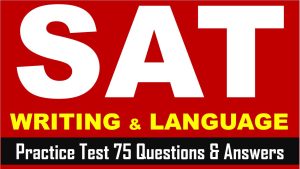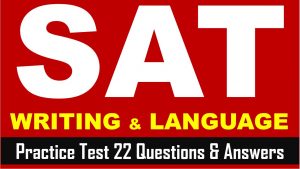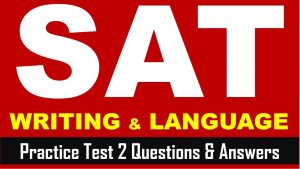Hi SAT Aspirants, welcome to AKVTutorials. As you know SAT (Scholastic Assessment Test) is a standard test, used for taking admission to undergraduate programs of universities or colleges of United States. SAT is developed and published by the College Board, an organization in United States, administered by the Educational Testing Service. Therefore, you need to do practice on SAT Reading Section, SAT Writing and Language Section. In this article, you will get SAT 2023 Writing and Language Practice Test 11 with Answer Keys AMBIPi
Instruction:
- In the passage below is accompanied by a number of questions.
- For some questions, you need to think how the passage might be revised to improve the expression of ideas.
- For other questions, you will consider how the passage might be edited to correct errors in sentence structure, usage, or punctuation.
- Some questions will direct you to an underlined portion of a passage.
- Other questions will direct you to a location in a passage or ask you to think about the passage as a whole.
SAT Writing & Language Section Passage
SAT Writing Passage Title: Thomas Nast, the Crusading Cartoonist.
“Stop them pictures!” Legend has it that the corrupt politician William “Boss” Tweed once used those words when ordering someone to offer a bribe to Thomas Nast, an artist who had become famous for cartoons that called for reforms to end corruption. 1 As a result, Tweed’s attempt to silence the artist failed, and Nast’s cartoons, published in magazines like Harper’s Weekly, actually played a key role in bringing Boss Tweed and his cronies to justice.
2 There were powerful political organizations in the 1860s and the 1870s. The organizations were known as “political machines” and started taking control of city governments. These political machines were able to pack legislatures and courts with hand-picked supporters by purchasing 3 votes, a form of election fraud involving the exchange of money or favors for votes. Once a political machine had control of enough important positions, its members were able to use public funds to enrich themselves and their friends. Boss Tweed’s Tammany Hall group, which controlled New York 4 City in the 1860s— stole more than $30 million, he equivalent of more than $365 million today.
5 Tweed had been elected to a single two-year term in Congress in 1852. Tammany Hall was so powerful and 6 corrupt that, the New York Times, commented “There is absolutely nothing . . . in the city which is beyond the reach of the insatiable gang.”
Given the extent of Tweed’s power, it is remarkable that a single cartoonist could have played such a significant role in bringing about his downfall. Nast’s cartoons depicted Tweed as a great big bloated thief. One of the artist’s most 7 famous images showed Tweed with a bag of money in place of his. 8 head. Another featured Tweed leaning against a ballot box with the caption “As long as I count the votes, what are you going to do about it?” These cartoons were so effective in part because many of the citizens who supported Tweed were illiterate and thus could not read the newspaper accounts of his criminal activities.
Nast’s cartoons, though, widely exposed the public to the injustice of Tweed’s political machine. Nast’s campaign to bring down Tweed and the Tammany Hall gang was ultimately successful. In the elections of 1871, the public voted against most of the Tammany Hall candidates, greatly weakening Tweed’s power. Eventually, Tweed and his gang were 9 persecuted for a number of charges, including fraud and larceny, and many of them were sent to jail. In 1875 Tweed escaped from jail and fled to Spain and unwittingly 10 brought about one final 11 pinnacle for the power of political cartoons: A Spanish police officer recognized Tweed from one of Nast’s cartoons. Consequently, Tweed was sent back to jail, and Nast was hailed as the man who toppled the great Tammany Hall machine.
SAT Writing & Language Practice Questions
SAT Writing Practice Test Question No 1
Which choice best maintains the sentence pattern already established in the paragraph?
Option A : No Change
Option B : Therefore
Option C : Furthermore
Option D : DELETE the underlined portion.
SAT Writing Practice Test Answer
Show/Hide Answer
Option D : DELETE the underlined portion.
because no transitional phrase or conjunctive adverb such as “therefore” or “furthermore” is needed between the sentences.
SAT Writing Practice Test Question No 2
Which choice most effectively combines the underlined sentences?
Option A : Powerful political organizations in the 1860s and the 1870s started taking control of city governments, and they were known as “political machines.”
Option B : Known as “political machines,” in the 1860s and the 1870s, political organizations that were powerful started taking control of city governments.
Option C : Known as “political machines,” in the 1860s and the 1870s, political organizations that were powerful started taking control of city governments.
Option D : In the 1860s and the 1870s, powerful political organizations known as “political machines” started taking control of city governments.
SAT Writing Practice Test Answer
Show/Hide Answer
Option D : In the 1860s and the 1870s, powerful political organizations known as “political machines” started taking control of city governments.
because they all contain unnecessary words or invert the logical order of words in ways that lead to vagueness and redundancy.
SAT Writing Practice Test Question No 3
Which choice provides the most effectively transition to the information that follows?
Option A : No Change
Option B : votes, being
Option C : votes, that is
Option D : votes, which it is
SAT Writing Practice Test Answer
Show/Hide Answer
Option A : No Change
because the participle “being” and the pronouns “that” and “which” are not needed to introduce the appositive phrase “a form of . . .,” which explains the concept of “purchasing votes.”
SAT Writing Practice Test Question No 4
Which choice results in the most effective transition to the information that follows in the paragraph?
Option A : No Change
Option B : city in the 1860s,
Option C : city in the 1860s,
Option D : city in the 1860s
SAT Writing Practice Test Answer
Show/Hide Answer
Option B : city in the 1860s,
because a dash cannot be used in conjunction with a comma to set off a nonessential clause. Either two commas or two dashes may be used, but not one of each.
SAT Writing Practice Test Question No 5
The writer is considering deleting the underlined sentence. Should the sentence be kept or deleted?
Option A : Kept, because it introduces the quote from the New York Times in the next sentence
Option B : Kept, because it adds a vital detail about Tweed that is necessary to understand his power.
Option C : Deleted, because it blurs the focus of the paragraph by introducing loosely related information
Option D : Deleted, because it contains information that undermines the main claim of the passage.
SAT Writing Practice Test Answer
Show/Hide Answer
Option C : Deleted, because it blurs the focus of the paragraph by introducing loosely related information
because while the sentence should be deleted, it does not undermine or challenge the main claim of the passage
SAT Writing Practice Test Question No 6
Which choice best maintains the sentence pattern already established in the paragraph?
Option A : No Change
Option B : corrupt, that the New York Times commented,
Option C : corrupt that the New York Times commented,
Option D : corrupt that the New York Times, commented
SAT Writing Practice Test Answer
Show/Hide Answer
Option C : corrupt that the New York Times commented,
because each includes one or more unnecessary commas.
SAT Writing Practice Test Question No 7
Which choice best maintains the sentence pattern already established in the paragraph?
Option A : No Change
Option B : famous and well-known
Option C : famous and commonly known
Option D : famous, commonly known
SAT Writing Practice Test Answer
Show/Hide Answer
Option A : No Change
because “well-known” and “commonly known” are repetitive when used with the adjective “famous,” which means widely known.
SAT Writing Practice Test Question No 8
Which choice adds the most relevant supporting information to the paragraph?
Option A : head; like many other Nast cartoons, that one was published in Harper’s Weekly
Option B : head; Nast would later illustrate Tweed’s escape from prison.
Option C : head, one depiction that omits Tweed’s signature hat.
Option D : head, an image that perfectly captured Tweed’s greedy nature.
SAT Writing Practice Test Answer
Show/Hide Answer
Option D : head, an image that perfectly captured Tweed’s greedy nature.
because they all contain irrelevant information. Information about Nast’s other cartoons, Tweed’s prison escape, and Tweed’s hat is not important to add to the paragraph, which is focused on the cartoons’ depictions of Tweed as a thief.
SAT Writing Practice Test Question No 9
Which choice best maintains the sentence pattern already established in the paragraph?
Option A : No Change
Option B : Persecuted on
Option C : Persecuted with
Option D : Persecuted on
SAT Writing Practice Test Answer
Show/Hide Answer
Option D : Persecuted on
because the word “persecuted” means that someone is harassed or oppressed, not that he or she is charged with a crime.
SAT Writing Practice Test Question No 10
Which choice best maintains the sentence pattern already established in the paragraph?
Option A : No Change
Option B : bringing
Option C : brings
Option D : has brought
SAT Writing Practice Test Answer
Show/Hide Answer
Option A : No Change
because the participle “bringing,” the present tense verb “brings,” and the present perfect tense verb “has brought” are not consistent with the other verbs in the sentence.
SAT Writing Practice Test Question No 11
Which choice completes the sentence with accurate data based on the graph?
Option A : No Change
Option B : triumph
Option C : culmination
Option D : apex
SAT Writing Practice Test Answer
Show/Hide Answer
Option B : triumph
because “pinnacle,” “culmination,” and “apex” all suggest the highest point or end of something. None of these words indicates the appropriate relationship between the recapture of Tweed and the impact of Nast’s cartoons.



